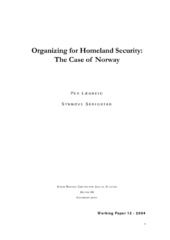| dc.contributor.author | Lægreid, Per | eng |
| dc.contributor.author | Serigstad, Synnøve | eng |
| dc.date.accessioned | 2006-06-21T14:13:00Z | |
| dc.date.accessioned | 2020-12-10T06:33:22Z | |
| dc.date.available | 2006-06-21T14:13:00Z | |
| dc.date.available | 2020-12-10T06:33:22Z | |
| dc.date.issued | 2004-11 | eng |
| dc.identifier.issn | 1503-0946 | |
| dc.identifier.uri | https://hdl.handle.net/1956/1373 | |
| dc.description.abstract | This paper examines the reorganization process in the Norwegian central administration for homeland security. As a central theme it explores why the proposal to radically reorganize the administration by replacing a network model with a hierarchical model resulted in a much more modest change to a hybrid agency model. Our theoretical approach is a broad political-institutional perspective, focusing on instrumental design, bargaining processes, institutional contexts and adaptation to external shock. The descriptive part of the paper traces the reorganization process, starting with the initiative taken by the Ministry of Justice in 1999 to establish a public commission and ending with the final parliamentary resolution in 2002. A striking feature of the process was negative coordination, indicating that the wish to coordinate was greater than the willingness to be coordinated. To understand why this was so we look at bureaucratic politics and bargaining between different interests and also at institutional identities and strong cultures and traditions within different governmental bodies. | en_US |
| dc.description.abstract | I dette notatet undersøkes reorganiseringen av samfunnsikkerhetsforvaltnigen i norsk sentralforvaltning. Et sentralt spørsmål er hvorfor forslaget fra Sårbarhetsutvalget om en radikal reorganisering gjennom å erstatte en nettverksmodell med opprettting av et departement for samfunnsikkerhet resulterte i langt mer moderate endringer i retning av en hybrid direktoratsmodell. Vår teoretiske tilnærming er et bredt politisk-institusjonelt perspektiv som fokuserer på instrumentell design, forhandlingsprosesser, betydningen av institusjonell kontekst og tilpasning til ytre sjokk. Den deskriptive delen av paperet følger reorgniseringsprosessen fra ininiativet ble tatt i Justisdepartementet i 1999, via Sårbarhetsutvaltet og stortingsmeldingen om samfunnsikkehet til stortingsbehandlingen i 2002. Et slående trekk ved prosessen var negativ samordning, som indikerer at ønske om å samordne var større enn viljen til å bli samordnet. For å forstå dette utfallet studeres forhandlingsprosesser mellom ulike myndigheter og institusjonelle identiteter, sterke kulturer og tradisjoner i ulike forvaltnignsområder som justis og forsvar. | no |
| dc.format.extent | 429976 bytes | eng |
| dc.format.mimetype | application/pdf | eng |
| dc.language.iso | eng | eng |
| dc.publisher | Stein Rokkan Centre for Social Studies | eng |
| dc.relation.ispartofseries | 12-2004 | |
| dc.relation.ispartofseries | Working Paper | en |
| dc.title | Organizing for Homeland Security: The Case of Norway | eng |
| dc.type | Working paper | eng |
| dc.subject.nsi | VDP::Samfunnsvitenskap: 200 | nob |
